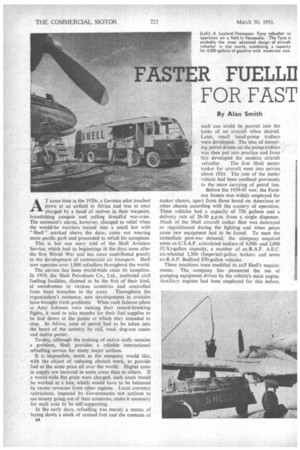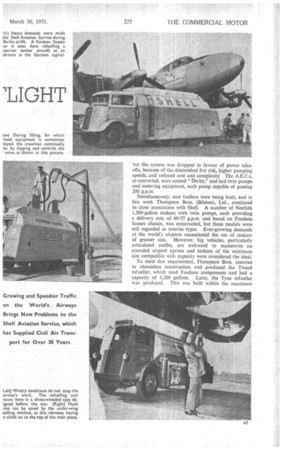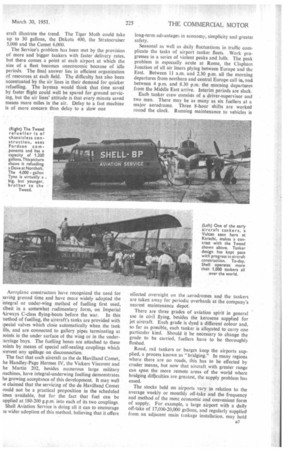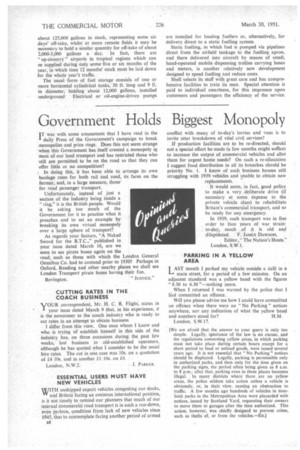STER FUELLI1 FOR FAST IIGHT
Page 38

Page 39

Page 40

Page 41

Page 42

If you've noticed an error in this article please click here to report it so we can fix it.
By Alan Smith AT some time in the 1920s, a German pilot touched down at an airfield in Africa and was at once charged by a band of natives in their warpaint, brandishing assegais and yelling dreadful war-cries. The aeronaut's alarm, however, changed to relief when the would-be warriors turned into a small hut with "Shell" marked above the door, came out wearing more pacific garb and proceeded to refuel his aeroplane.
This is but one story told of the Shell Aviation Service, which had its beginnings in the days soon after the first World War and has since contributed greatly to the development of commercial air transport. Shell now operates over 1,000 refuellers throughout the world.
The service has been world-wide since its inception. In 1919, the Shell Petroleum Co., Ltd., instituted civil fuelling facilities, claimed to be the first of their kind, at aerodromes in various countries and controlled from local branches in the areas. Throughout the organization's existence, new developments in aviation have brought fresh problems When such famous pilots as Amy Johnson were making their record-breaking flights, it used to take months for their fuel supplies to be laid down at the points at which they intended to stop. In Africa, cans of petrol had to be taken into the heart of the country by rail, road, dug-out canoe and native porter.
To-day, although the training of native staffs remains a problem, Shell provides a reliable international refuelling service for many major airlines.
It is impossible, much as the company would like, with the object of reducing clerical work, to provide fuel at the same price all over the world. Higher costs in supply are incurred in some areas than in others. If a world-wide flat price were charged, such areas would be worked at a loss, which would have to be balanced by excess revenues from other regions. Local currency restrictions, imposed by Governments not anxious to see money going out of their countries, make it necessary for each area to be self-supporting.
In the early days, refuelling, was merely a matter of laying down a stock of canned fuel and the contents of B4 each can could be poured into the tanks of an aircraft when desired. Later, small hand-pump trolleys were developed. The idea of mounting petrol drums on the pump trolleys was then put into practice and from this developed the modern aircraft refueller. The first Shell motor tanker for aircraft went into service about 1924. The role of the motor vehicle had been confined previously to the mere carrying of petrol tins.
Before the 1939-45 war, the Fordson Sussex was widely employed for tanker chassis, apart from those based on American or other chassis according with the country of operation. These vehicles had a capacity of 750 gallons and a delivery rate of 26-30 g.p.m. from a single dispenser. Much of the Shell aircraft tanker fleet was destroyed or requisitioned during the fighting and when peace came new equipment had to be found. To meet the immediate post-war demand, the company acquired some ex-U.S.A.F. articulated tankers of 4,000and 2,000 (U.S.)-gallon capacity, a number of ex-R.A.F. A.E.C. six-wheeled 2,500 (Imperial)-gallon tankers and some ex-R.A.F. Bedford 850-gallon vehicles.
These machines were modified to suit Shell's requirements. The company has pioneered the use of pumping equipment driven by the vehicle's main engine. Auxiliary engines had been employed for this before,
but the system was dropped in favour of power takeoffs, because of the diminished fire risk, higher pumping speeds, and reduced cost and complexity The A.E.C.s, as converted, were named " Derby," and had twin pumps and metering equipment, each pump capable of passing 200 g.p.m.
Simultaneously, new fuellers were being built, and in this work Thompson Bros. (Bilston), Ltd., continued its close association with Shell. A number of Norfolk 1,200-gallon tankers with twin pumps, each providing a delivery rate of 60-75 g.p.m. and based on Fordson Sussex chassis, was constructed, but these models were still regarded as interim types. Ever-growing demands at the world's airports necessitated the use of tankers of greater size. However, big vehicles, particularly articulated outfits, are awkward to manceuvre on crowded airport aprons and tankers of the minimum size compatible with capacity were considered the ideal.
To meet this requirement, Thompson Bros. resorted to chassisless construction and produced the Tweed refueller, which used Fordson components and had a capacity of 1,200 gallons. Later, the Tyne refueller was produced. This was built within the maximum permissible dimensions applicable in this country and had a capacity of 4,000 gallons. The Tyne is now in production. It was envisaged in 1943, but the war held up development. The delivery rate from the two pumps of the Tyne together totals .400 g.p.m. Shell's use of special treatments for the inside of fueller tanks, hot-tinned pipework and micro-filters virtually eliminate the possibility of fuel contamination by fine particles of rust and so on.
Different aircraft require different refuelling techniques and tankers are built to be capable of dealing with a number of types. Most aircraft have to be fuelled through filler caps in the top surfaces of the wings, which contain as many as, seven or eight tanks. To be capable of fuelling large aircraft, such as the Boeing 377 Stratocruiser, tankers have to carry up to 120 ft. of hose on power-operated reels so that tanks at the extreme tips of the wings may be reached without having to manceuvre the vehicle. For fuelling rates up to 70-80 g.p.m., 11-in. diameter hoses are used, for 100-130 g.p.m., 2-in, hoses and for rates up to 200 g.p.m., 2f in.
Hoses consist of a synthetic-rubber core, a binding of nylon and cotton, and an outer casing of natural rubber. A length of copper wire is contained in each hose as a conductor for static electricity. Elaborate precautions are taken against fire risk. Tankers are electrically bonded so that no part of the vehicle can hold a charge at a higher potential than another and there is no chance of the jumping of a spark. All electrical equipment is flameproof or totally sealed, and all vehicles have double-pole wiring run in continuous conduit.
On refuelling operations, the tanker is connected to that part of the aircraft to which it is itself electrically bonded (either the nose or tail wheel) by a length of wire. The crew follows a strict drill. No one may even wear metal studs in his shoes.
Practically every aerodrome in the free world is served by Shell. At many of them, being only small fields, the installation is simple, but tankers are employed at the busier airports. Not so many airports are served now as before the war. To-day's aircraft have increased range and do not have to make so many intermediate stops for fuel. However, the volume of work done, on a basis of gasoline supplied, has increased enormously with the post-war expansion of air traffic.
The airway expansion, the concentration on fewer airfields and the increased tankage capacity of modern aircraft have presented the Service with its most urgent difficulty of to-day—supplying greater quantities of fuel at each aerodrome at an even more rapid pace. Comparative figures of the tankage capacity of different air
craft illustrate the trend. The Tiger Moth could take up to 30 gallons, the Dakota 400, the Stratocruiser 5,000 and the Comet 6,000.
The Service's problem has been met by the provision of more and bigger tankers with faster delivery rates, but there comes a point at each airport at which the size of a fleet becomes uneconomic because of idle periods. The final answer lies in efficient organization of resources at each field. The difficulty has also been accentuated by the air lines in their demand for quicker refuelling. The layman would think that time saved by faster flight could well be spared for ground servicing, but the air lines' attitude is that every minute saved means more miles in the air. Delay to a fast machine is of more concern than delay to a slow one Aeroplane constructors have recognized the need for saving ground time and have mole widely adopted the integral or under-wing method of fuelling first used, ilbeit in a somewhat rudimentary form, on Imperial kirways C-class flying-boats before the war. In this nethod of fuelling, the aircraft's tanks are provided with ipeeial valves which close automatically when the tank ills, and are connected to gallery pipes terminating at vints in the under surface of the wing or in the under:arriage bays. The fuelling hoses are attached to these )oints by means of special self-sealing couplings which nevent any spillage on disconnection.
The fact that such aircraft as the de Havilland Comet, he Handley-Page Hermes IV, the Vickers Viscount and he Martin 202, besides numerous large military nachines, have integral-underwing fuelling demonstrates he growing acceptance of this development. It may well ie claimed that the servicing of the de Havilland Comet vould not be a practical proposition in the scheduled imes available, but for the fact that fuel can be upplied at 180-200 g.p.m. into each of its two couplings.
Shell Aviation Service is doing all it can to encourage le wider adoption of this method, believing that it offers long-term advantages in economy, simplicity and greater safety, Seasonal as well as daily fluctuations in traffic complicate the tasks of airport tanker fleets. Work progresses in a series of violent peaks and lulls. The peak problem is especially acute at Rome, the Clapham Junction of all air liners plying between Europe and the East. Between 11 a.m. and 2.30 p.m. all the morning departures from northern and central Europe call in, and between 4 p.m. and 8.30 p.m. the morning departures from the Middle East arrive. Interim periods are slack.
Each tanker crew consists of a driver-supervisor and two men. There may be as many as six fuellers at a major aerodrome. Three 8-hour shifts are worked round the clock. Running maintenance to vehicles is effected overnight on the .aerodromes and the tankers are taken away for periodic overhauls at the company's nearest maintenance depot.
There are three grades of aviation spirit in general use in civil flying, besides the kerosene supplied for jet aircraft. Each grade is dyed a different colour and, so far as possible, each tanker is allocated to carry one particular kind. Should it be necessary to change the grade to be carried, fuellers have to be thoroughly flushed.
Road, rail tankers or barges keep the airports supplied, a process known as "bridging." In many regions where there are no roads, this has to be effected by cruder means, but now that aircraft with greater range can span the more remote areas of the world where bridging difficulties are greatest, the supply problem has eased.
The stocks held on airports vary in relation to the average weekly or monthly off-take and the frequency and method of the most economic and convenient form of supply. For example, a large airport with a daily off-take of 17,000-20,000 gallons, and regularly supplied from an adjacent main tankage installation. may hold about 125,000 gallons in stock, representing some six days' off-take, whilst at more remote fields it may be necessary to hold a similar quantity for off-take of about 2,000-3,000 gallons a day. In fact, there are " up-country " airports in tropical regions which can oe supplied during only some five or six months of the year, in which time 12 months' stock must be laid down for the whole year's traffic.
The usual form of fuel storage consists of one or more horizontal cylindrical tanks, 30 ft. long and 9 ft. in diameter, holding about 12,000 gallons, installed underground Electrical or oil-engine-driven pumps are installed for loading fuellers or, alternatively, for delivery direct to a static fuelling system.
Static fuelling, in which fuel is pumped via pipelines direct from the airfield tankage to the fuelling apron, and there delivered into aircraft by means of small, hand-operated mobile dispensing trollies carrying hoses and meters, is another 1 elatively new development designed to speed fuelling and reduce costs.
Shell selects its staff with great care and has comprehensive facilities to train its men. Special attention is paid to individual smartness, for this impresses upon customers and passengers the efficiency of the service.












































































